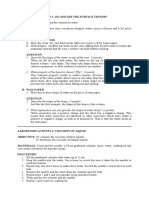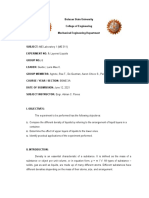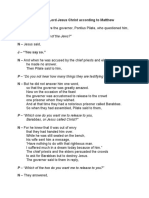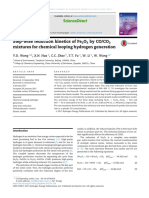Experiment 1 Online 1
Experiment 1 Online 1
Uploaded by
Clarence BautistaCopyright:
Available Formats
Experiment 1 Online 1
Experiment 1 Online 1
Uploaded by
Clarence BautistaOriginal Title
Copyright
Available Formats
Share this document
Did you find this document useful?
Is this content inappropriate?
Copyright:
Available Formats
Experiment 1 Online 1
Experiment 1 Online 1
Uploaded by
Clarence BautistaCopyright:
Available Formats
3. Repeat step two more times to make three trials.
Record the marble’s travel time in
each trial.
Laboratory activity: 1 4. Remove the marble and the water from the cylinder and dry both of them.
5. Repeat steps 1 and 4 and use pancake syrup instead of water.
DO AND SEE THE ST
6. Wash and dry the cylinder and the marble.
OBJECTIVE: To observe surface tension in water. 7. Repeat 1 and 4 and use cooking oil.
8. Wash and dry the cylinder and the marble.
MATERIALS: a 25 centavo coin, a medicine dropper, water, a piece of tissue and a 2x2
piece of wax paper. QUESTIONS:
PROCEDURE: 1. In which did the marble take a longest time to reach the bottom?
2. How would you rank the liquids in order of decreasing viscosity?
A 3. What explanation can you give for the observed viscosities?
1. Place the clean, dry coin float on the table over a piece of dry tissue paper.
2. With dropper, carefully put water on the coin, adding little by little until it reaches
the maximum amount that the coin’s surface can hold without spilling. Laboratory activity 3
QUESTIONS:
CAPILLARY ACTION IN COLORS!
1. Describe the shape of the water on top of the coin.
2. What property of the liquid is shown? Why? OBJECTIVE: To model capillary action using paper towels and water.
B MATERIALS: 3 empty short glasses, 2 cups water, 2 colors of food coloring, such as
1. Place two to three drops of water on the piece of wax paper. yellow and blue, 2 paper towels.
QUESTIONS:
1. Describe the shape of the drops. PROCEDURE:
2. What explanation can you give for the shape of water drops?
1. First, fill two glasses with 1 cup water each.
Laboratory activity 2 2. Next, add 4 drops of one color, of food coloring to one glass and 4 drops of the
other food coloring to the other glass. This will help you observe the capillary
VISCOSITY OF LIQUID action easier.
3. Now fold each of your paper towels vertically in half twice, so you have two long,
OBJECTIVE: To compare the viscosity of three liquids. skinny paper towels.
4. Put one end in the colored water and one end in the empty glass.
To determine the viscosity of sample liquids.
5. Repeat step 4, for the other paper towel and colored water.
MATERIALS: Clean and dry marble, a 25 ml graduated cylinder, timer, water, cooking 6. Watch the glasses and see what happens.
oil and pancake syrup.
PROCEDURE: QUESTIONS:
A. 1. Describe what happen in the paper towel and water.
1. Fill the graduated cylinder with water up to 20 ml. 2. What property of liquid shown? Why?
2. Drop the marble into the water. Use a timer to record the time it takes for the marble
to reach the bottom.
You might also like
- 67surface Water Lab Report: ProblemDocument4 pages67surface Water Lab Report: ProblemislandNo ratings yet
- Water Lab PDFDocument4 pagesWater Lab PDFjosafdi askdfhNo ratings yet
- Penny LabDocument7 pagesPenny LabDeepkaran BrarNo ratings yet
- Laboratory Activity 1: Do and See The Surface Tension: 1. Describe The Shape of The Water On Top of The Coin. (5 Points)Document3 pagesLaboratory Activity 1: Do and See The Surface Tension: 1. Describe The Shape of The Water On Top of The Coin. (5 Points)Clarence Bautista100% (2)
- Unleash The Scientist Within YouDocument4 pagesUnleash The Scientist Within YouGleynne MilloradaNo ratings yet
- Activity 2 Water and Its PropertiesDocument7 pagesActivity 2 Water and Its PropertiesDan Christian BlanceNo ratings yet
- Activity Worksheets Properties of LiquidsDocument8 pagesActivity Worksheets Properties of LiquidscarloabadianolopezNo ratings yet
- Activity Worksheets Properties of LiquidsDocument8 pagesActivity Worksheets Properties of Liquidskyrabidua3No ratings yet
- Jon Emmanuel G. Velasco 3RD - Quarter - Peta Homelab Lab WorksheetDocument18 pagesJon Emmanuel G. Velasco 3RD - Quarter - Peta Homelab Lab WorksheetdjisthecoolNo ratings yet
- Pouring Water TemplateDocument2 pagesPouring Water Templateapi-734979884No ratings yet
- ch222 Activity SheetDocument4 pagesch222 Activity SheetWalter PerryNo ratings yet
- Exploring Properties of Liquids: Activity #1: Moving WaterDocument2 pagesExploring Properties of Liquids: Activity #1: Moving WaterJoana Mae Balilia DiazNo ratings yet
- Water LabDocument8 pagesWater Labathansor harrisNo ratings yet
- Results and Discussions-chemDocument11 pagesResults and Discussions-chemChristiane Alfonzo GalveNo ratings yet
- WaterDocument2 pagesWater23100584No ratings yet
- 63c4d47f35629 Science Activities Booklet Book 7Document8 pages63c4d47f35629 Science Activities Booklet Book 7maazthebest34No ratings yet
- ME Laboratory 1 Experiment No. 1Document7 pagesME Laboratory 1 Experiment No. 1Aaron Choco De GuzmanNo ratings yet
- Atoms and MoleculesDocument3 pagesAtoms and MoleculesddokisinNo ratings yet
- JASMIN.D22-dlp With Attached Worksheets - Properties of Saturated, Unsaturated and Supersaturated SolutionDocument8 pagesJASMIN.D22-dlp With Attached Worksheets - Properties of Saturated, Unsaturated and Supersaturated SolutionAbigail JasminNo ratings yet
- Surface Tension LabDocument1 pageSurface Tension LabmaniyaNo ratings yet
- Volcano ActivityDocument6 pagesVolcano ActivityRafaela Estrella ManalangNo ratings yet
- Lab Report Template N 084224Document13 pagesLab Report Template N 084224Jose B. Bajar llNo ratings yet
- Experiment No 1Document7 pagesExperiment No 1Anthony AbesadoNo ratings yet
- Walking Water Science Experiment: Items NeededDocument1 pageWalking Water Science Experiment: Items Neededhazel viloriaNo ratings yet
- Properties of Water Lab ActivityDocument8 pagesProperties of Water Lab ActivityStephanie Espinoza100% (1)
- VolcanoDocument4 pagesVolcanoRona Carmen LabradorNo ratings yet
- OsmosisDocument3 pagesOsmosisbigdanheatherNo ratings yet
- Properties of Water Lab 2012aDocument8 pagesProperties of Water Lab 2012aFatien VioLet's SmilezsiieNo ratings yet
- Lab Sheet 1Document2 pagesLab Sheet 1MELISSA NANONGNo ratings yet
- Activity 1: Before We Start With Our Discussions, I Would Like You To Prepare at Least A Glass ofDocument5 pagesActivity 1: Before We Start With Our Discussions, I Would Like You To Prepare at Least A Glass ofHord JordanNo ratings yet
- Capillary Action ExperimentDocument3 pagesCapillary Action ExperimentreyjohniliwiliwNo ratings yet
- Explain It With Atoms & Molecules: 392 Middle School Chemistry UnitDocument4 pagesExplain It With Atoms & Molecules: 392 Middle School Chemistry UnitpjcolitaNo ratings yet
- Chemistry Quick Lab Sugar Density LayersDocument3 pagesChemistry Quick Lab Sugar Density LayersCarla MirandaNo ratings yet
- Paper MakingDocument1 pagePaper Makingomali.a.bartNo ratings yet
- Guide QuestionsDocument4 pagesGuide QuestionsJESUSA KRISTA JARDIOLINNo ratings yet
- 7LAB16 U09 RespirationDocument6 pages7LAB16 U09 Respirationas61217No ratings yet
- EXPERIMENT 1.0: Factors Affecting Rate in A Chemical ReactionDocument2 pagesEXPERIMENT 1.0: Factors Affecting Rate in A Chemical ReactionElla NanaNo ratings yet
- KG2 EvsDocument8 pagesKG2 Evs123troylumbNo ratings yet
- Alexandre Nicole Baylan ScienceDocument4 pagesAlexandre Nicole Baylan ScienceNykko BaylanNo ratings yet
- Name - Year & SectionDocument3 pagesName - Year & SectionPaul Senen DiduloNo ratings yet
- DEMO Math Lesson PlanDocument6 pagesDEMO Math Lesson PlanKirt MalalisNo ratings yet
- Respiration: The Big Idea: Explore Different Aspects of The Respiratory SystemDocument6 pagesRespiration: The Big Idea: Explore Different Aspects of The Respiratory SystemYerick MartinezNo ratings yet
- Learning Camp Science Lesson 21-30Document4 pagesLearning Camp Science Lesson 21-30Anna Liza GomezNo ratings yet
- Experiment SCIENCE 6Document5 pagesExperiment SCIENCE 6Marietcho MacalisangNo ratings yet
- Science Activity Sheets - 4th QuarterDocument23 pagesScience Activity Sheets - 4th QuarterJeniffer De LeonNo ratings yet
- Science Lesson Week 2 and 3Document26 pagesScience Lesson Week 2 and 3Rodgen GerasolNo ratings yet
- Dissolving and The Particle Theory: Where Does The Sugar Go?Document2 pagesDissolving and The Particle Theory: Where Does The Sugar Go?jules blanco100% (1)
- g2 l2.1 Liquids Have PropertiesDocument6 pagesg2 l2.1 Liquids Have Propertiesjamiezoe131No ratings yet
- Gen ChemDocument5 pagesGen ChemPatricia Ann A. MateoNo ratings yet
- Act 4Document1 pageAct 4Gerald LegesnianaNo ratings yet
- Activity 4 What Changes Take Place When Water Is Left in An Open Container in A Closed ContainerDocument2 pagesActivity 4 What Changes Take Place When Water Is Left in An Open Container in A Closed ContainerEugene ColotNo ratings yet
- Blue Bottle Experiment: 1. Prepare MaterialsDocument5 pagesBlue Bottle Experiment: 1. Prepare MaterialsVladNo ratings yet
- Aguerra Mary Anjaeline G. EXERCISES 2 PROPERTIES OF LIQUIDS DUE TO INTERMOLECULAR FORCES EXHIBITDocument4 pagesAguerra Mary Anjaeline G. EXERCISES 2 PROPERTIES OF LIQUIDS DUE TO INTERMOLECULAR FORCES EXHIBITCristine CruzNo ratings yet
- Properties of Water - ActivityDocument5 pagesProperties of Water - ActivitysciencewomanNo ratings yet
- Detailed Lesson Plan in ScienceDocument2 pagesDetailed Lesson Plan in ScienceNyssa Isobel McSab100% (2)
- Traditional Lesson Plan ScienceDocument8 pagesTraditional Lesson Plan ScienceJojit GarciaNo ratings yet
- Water Labs FullDocument4 pagesWater Labs FulljohnosborneNo ratings yet
- Gen. Chem. Module 1 PTDocument9 pagesGen. Chem. Module 1 PTjulianneNo ratings yet
- Activity ZoneDocument5 pagesActivity ZoneSakshamNo ratings yet
- Wonderful Water Experiments for Elementary Students - Science Book for Kids 9-12 | Children's Science Education BooksFrom EverandWonderful Water Experiments for Elementary Students - Science Book for Kids 9-12 | Children's Science Education BooksNo ratings yet
- Pr2 Grp3 First Revision For Chapter 1 2Document9 pagesPr2 Grp3 First Revision For Chapter 1 2Clarence BautistaNo ratings yet
- Practical Research 2 Presented by The Group 3: San Sebastian Cathedral SchoolDocument9 pagesPractical Research 2 Presented by The Group 3: San Sebastian Cathedral SchoolClarence BautistaNo ratings yet
- How To Collect Herbarium Specimens A Guide Prepared by The Western Australian Herbarium February 2008Document8 pagesHow To Collect Herbarium Specimens A Guide Prepared by The Western Australian Herbarium February 2008Clarence BautistaNo ratings yet
- Making An HerbariumDocument20 pagesMaking An Herbariumbrosucd69No ratings yet
- Diocese of Tarlac Sto. Cristo Parish Burot, Tarlac CityDocument1 pageDiocese of Tarlac Sto. Cristo Parish Burot, Tarlac CityClarence BautistaNo ratings yet
- The Passion of Our Lord Jesus Christ According To MatthewDocument4 pagesThe Passion of Our Lord Jesus Christ According To MatthewClarence BautistaNo ratings yet
- To All The Bishops and The Diocesan AdministratorsDocument3 pagesTo All The Bishops and The Diocesan AdministratorsClarence BautistaNo ratings yet
- QUESTIONNAIREDocument3 pagesQUESTIONNAIREClarence Bautista100% (1)
- REVISED Oratio Imperata Covid 19 EngDocument1 pageREVISED Oratio Imperata Covid 19 EngClarence Bautista100% (1)
- 2113_2014_AMD1_Reff2019Document8 pages2113_2014_AMD1_Reff2019Virendra UpadhyayNo ratings yet
- Internal Grinding in LatheDocument28 pagesInternal Grinding in Lathechandramohan dNo ratings yet
- Ndejje University: Faculty of EngineeringDocument5 pagesNdejje University: Faculty of EngineeringCivil KittieNo ratings yet
- Clay ModelingDocument1 pageClay ModelingRuturaj MohantyNo ratings yet
- Earthing Tool CalculatorDocument36 pagesEarthing Tool CalculatorJejomar ErebarenNo ratings yet
- ECE18R171 Electronic Devices ECE18R171 Electronic Devices: Course Objective(s)Document2 pagesECE18R171 Electronic Devices ECE18R171 Electronic Devices: Course Objective(s)Jeya Prakash KNo ratings yet
- Ground Bearing Concrete Slabs - Chapter 2Document37 pagesGround Bearing Concrete Slabs - Chapter 2share4learn100% (1)
- Westergaard Stress Solution Method PDFDocument2 pagesWestergaard Stress Solution Method PDFEmilia Elena MilutinoviciNo ratings yet
- ST7008 Prestressed StructuresDocument15 pagesST7008 Prestressed StructuresSethuraman SundararajanNo ratings yet
- MAS_A456_Nervia_TDS,MSDSDocument8 pagesMAS_A456_Nervia_TDS,MSDSkatesuruizrebutiaco022102No ratings yet
- Calorific Value of Coal - A Useful DetailDocument5 pagesCalorific Value of Coal - A Useful Detailkaruna346No ratings yet
- 1 s2.0 S0048969722040724 MainDocument24 pages1 s2.0 S0048969722040724 MainMihaiNo ratings yet
- Valve Material Specification General Notes: Annexure-I (To VMS)Document5 pagesValve Material Specification General Notes: Annexure-I (To VMS)sabareeshNo ratings yet
- Ionic Solutions PDFDocument44 pagesIonic Solutions PDFGellene GarciaNo ratings yet
- (Asce) ST 1943-541X 0002216Document15 pages(Asce) ST 1943-541X 0002216DuraBraceNo ratings yet
- 4-Masonry-1700143109.Candidate Written SubstructureDocument4 pages4-Masonry-1700143109.Candidate Written SubstructureHamisiNo ratings yet
- Step Wise Reduction Kinetic of Fe2O3Document9 pagesStep Wise Reduction Kinetic of Fe2O3talhanafees16595No ratings yet
- Ves 5145 R3Document10 pagesVes 5145 R3danikakaNo ratings yet
- Use of Waste Materials in Hotm Mix Asphalt STP1193-EB.20405 PDFDocument304 pagesUse of Waste Materials in Hotm Mix Asphalt STP1193-EB.20405 PDFSri RamyaNo ratings yet
- Flat IronDocument15 pagesFlat IronJane Quenie Caera LibrandaNo ratings yet
- Concrete Slab CollectorsDocument1 pageConcrete Slab CollectorsCharugalla Jeevan Phani Sreeram100% (1)
- Tempilstik Thermal ChalksDocument6 pagesTempilstik Thermal ChalksansarALLAAHNo ratings yet
- ColumnsDocument10 pagesColumnsحوراءNo ratings yet
- Qualitative Analysis of Cations and AnionsDocument24 pagesQualitative Analysis of Cations and AnionsNidhi Chaudhary33% (3)
- MSFC Spec 2497fDocument16 pagesMSFC Spec 2497fgooogaNo ratings yet
- C Number Stage Number Revisio N Locatio N Client Number Record Date Total Quantit yDocument32 pagesC Number Stage Number Revisio N Locatio N Client Number Record Date Total Quantit yRavichandran DNo ratings yet
- Derbigum SP v002Document2 pagesDerbigum SP v002ThuthuNo ratings yet
- Chlor-Alkali Production by Electrochemical ProcessDocument54 pagesChlor-Alkali Production by Electrochemical Processkivumbi AchileoNo ratings yet
- PDADocument55 pagesPDAMuhammad Hadian ShidiqNo ratings yet
- SAFT BatteryDocument22 pagesSAFT BatteryMohamed MeeranNo ratings yet


































































































